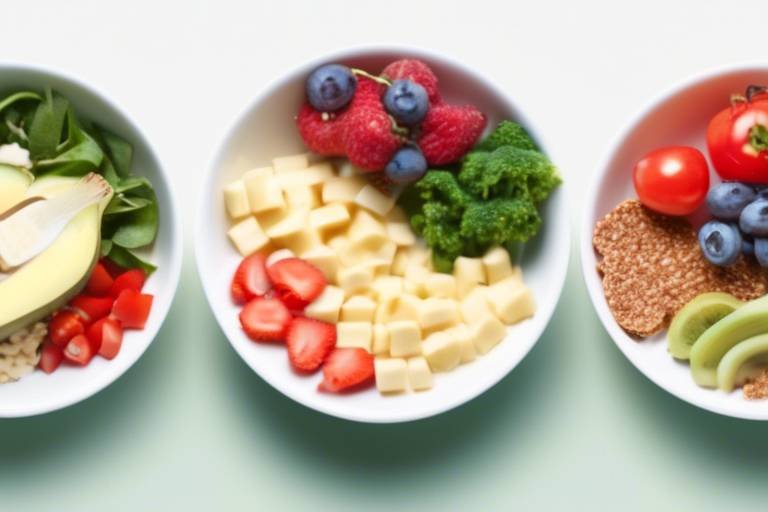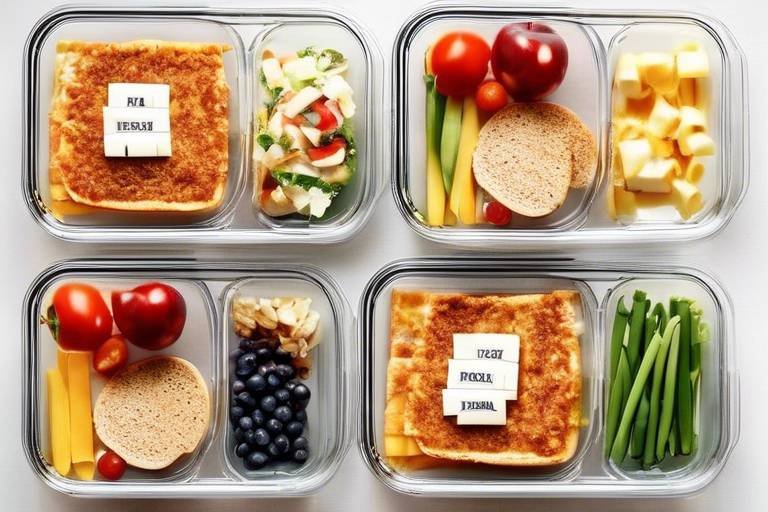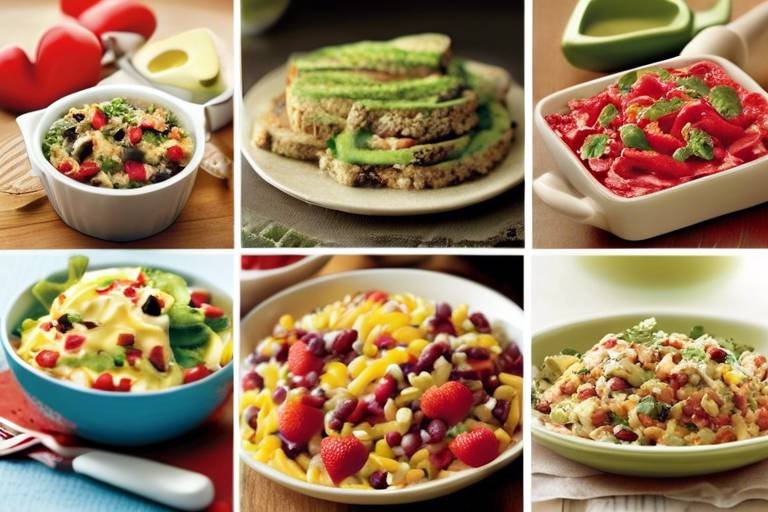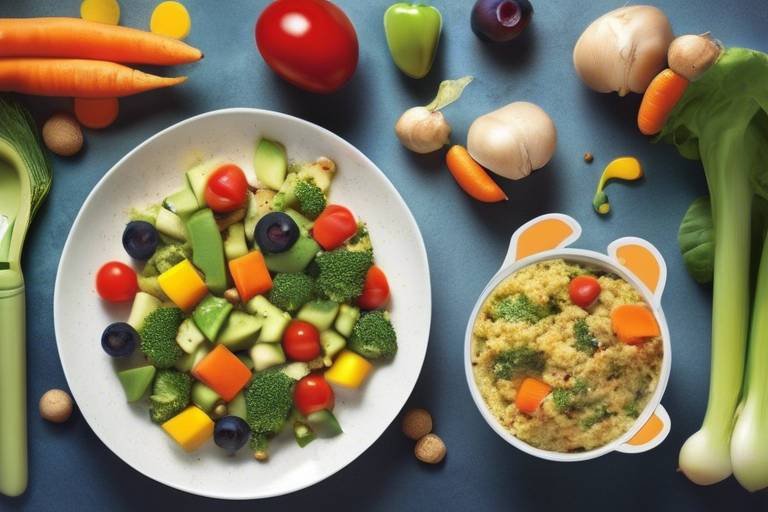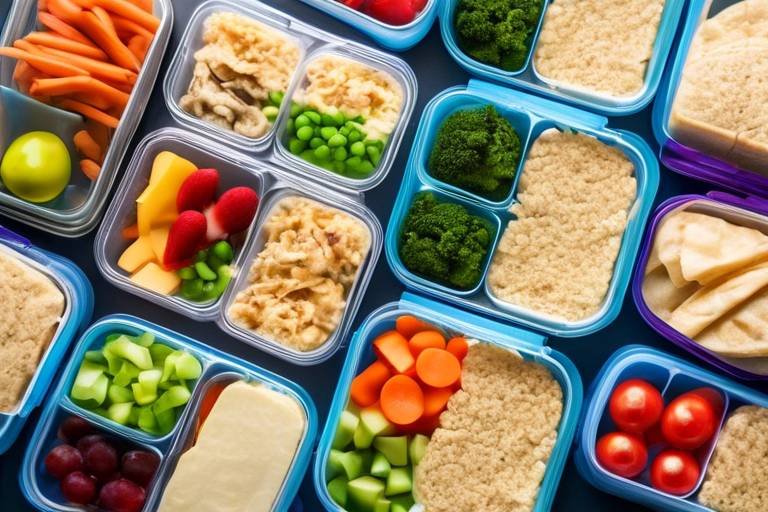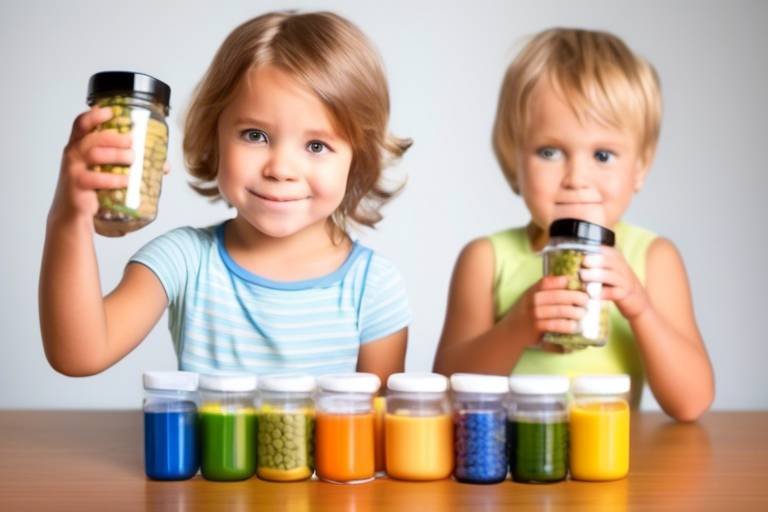Kid-Friendly Foods Packed with Probiotics
When it comes to keeping our little ones healthy, gut health is a big deal! You might be wondering, what’s the secret ingredient? Well, it’s probiotics! These tiny superheroes are live microorganisms that can do wonders for your child's digestive system and overall health. In this article, we’ll explore some delicious and nutritious foods that are packed with probiotics, making mealtime not just healthy but also exciting for your kids. Say goodbye to mealtime battles and hello to tasty treats that are good for their tummies!
So, what exactly are probiotics? Picture them as the friendly bacteria that live in our gut, helping to keep everything running smoothly. They play a crucial role in digestion, immune function, and even mood regulation. For children, having a healthy gut is essential for proper growth and development. Probiotics can help prevent tummy troubles, boost immunity, and even support mental health. It’s like giving your child a little shield against those pesky germs floating around!
Now that we understand the importance of probiotics, let’s dive into some kid-friendly foods that are rich in these beneficial bacteria. Incorporating these foods into your child's diet can be easy and fun! From creamy yogurts to tangy kefir, there’s a world of flavors waiting to be explored. Here are some of the top probiotic-rich foods that your kids will love:
- Yogurt: A classic favorite, yogurt is not only delicious but also versatile. It can be enjoyed on its own, mixed with fruits, or used in smoothies.
- Kefir: This fermented drink is like a supercharged yogurt. It’s packed with probiotics and has a unique, tangy flavor that kids might find intriguing.
- Fermented Vegetables: Foods like sauerkraut and pickles can be surprisingly tasty and are excellent sources of probiotics. With a little creativity, you can make these fun for your kids!
Yogurt is often the first thing that comes to mind when we think of probiotic foods. Its creamy texture and sweet flavors make it a hit with kids. But did you know that not all yogurts are created equal? Some are loaded with sugars and preservatives, which can negate their health benefits. When choosing yogurt, look for those labeled with “live and active cultures.” These are the good bacteria that will help your child's gut thrive. You can even involve your kids in the selection process—let them choose their favorite flavors or toppings to make it more exciting!
Reading labels can be a bit of a chore, but it’s worth it! Here’s a quick guide to help you choose the best yogurt:
| What to Look For | What to Avoid |
|---|---|
| Live and active cultures | High amounts of added sugars |
| Whole milk or low-fat options | Artificial flavors and colors |
| Plain yogurt for versatility | Preservatives |
Want to make yogurt even more fun? Try these simple and creative recipes that your kids will love:
- Yogurt Parfaits: Layer yogurt with fresh fruits and granola for a colorful and nutritious snack.
- Smoothies: Blend yogurt with fruits and a splash of juice for a refreshing drink.
- Frozen Yogurt Bites: Spoon yogurt into ice cube trays, add fruit, and freeze for a cool treat!
Next up is kefir—a fermented drink that’s like yogurt’s cool cousin. It’s packed with even more probiotics and nutrients. Introducing kefir to your child's diet can be a fun adventure! Start by offering small amounts mixed with their favorite fruits or cereals. The tangy flavor might take a little getting used to, but once they do, they’ll love it! Plus, you can use kefir in smoothies or salad dressings for an extra probiotic boost.
Fermented vegetables like sauerkraut and pickles can be a fantastic source of probiotics, but getting kids to eat them can be a challenge. The key is to make them fun and flavorful! You can try adding them to sandwiches, tacos, or even pizzas. The crunchiness and tangy taste can make these veggies more appealing. Plus, involving your kids in the preparation can spark their interest in trying new foods!
One of the best ways to get kids excited about fermented foods is to let them help in the kitchen. Here are some fun ideas:
- Have a pickle-making party where kids can choose their spices and flavors.
- Encourage them to create their own unique fermented veggie mix by combining different vegetables.
- Get creative with presentations—make veggie skewers or colorful salads!
When it comes to storing probiotic-rich foods, safety is crucial. Always check expiration dates and store these foods properly to maintain their benefits. Here are some quick tips:
- Keep yogurt and kefir in the fridge and consume them before the expiration date.
- Store fermented vegetables in airtight containers to prevent spoilage.
- Always wash your hands before handling any food to avoid contamination.
1. What are probiotics?
Probiotics are live bacteria that are beneficial for your digestive system and overall health.
2. Why are probiotics important for kids?
Probiotics help maintain a healthy gut, support immune function, and can even improve mood and behavior.
3. How can I incorporate more probiotics into my child's diet?
You can include foods like yogurt, kefir, and fermented vegetables in their meals and snacks.
4. Are there any side effects of probiotics?
Most children tolerate probiotics well, but it's always best to consult with a healthcare provider if you have concerns.

Understanding Probiotics
Probiotics are often described as the good bacteria that help maintain a healthy gut. These tiny microorganisms play a crucial role in our digestive system, particularly for children, whose bodies are still developing. Imagine your gut as a bustling city, where probiotics are the friendly neighbors keeping everything running smoothly. When children consume probiotics, they can experience a range of benefits that contribute to their overall well-being.
One of the primary advantages of probiotics is their ability to enhance digestive health. They help break down food, absorb nutrients, and prevent the growth of harmful bacteria. This is especially important for kids, as a healthy gut can lead to better nutrient absorption, which is essential for their growth and development. Additionally, probiotics can boost the immune system, helping children fend off illnesses and infections. In fact, studies have shown that children who regularly consume probiotic-rich foods tend to have fewer colds and gastrointestinal issues.
But how do these little warriors work their magic? Probiotics help maintain a balanced gut microbiome, which is the community of microorganisms living in our intestines. A balanced microbiome is critical for good health, as it helps regulate digestion, metabolism, and even mood. When children consume antibiotics or experience stress, their gut microbiome can become imbalanced, leading to digestive problems and other health issues. This is where probiotics come into play, as they can help restore that balance.
Incorporating probiotics into your child's diet can be as simple as adding a few delicious foods. Some of the best sources of probiotics include:
- Yogurt: Creamy and sweet, yogurt is a favorite among kids and a fantastic source of probiotics.
- Kefir: This tangy fermented drink is packed with even more probiotics than yogurt.
- Fermented vegetables: Foods like sauerkraut and pickles can be enjoyable when prepared creatively.
In summary, understanding probiotics is key to promoting your child's gut health. By introducing them to probiotic-rich foods, you not only enhance their digestive system but also support their immune function and overall health. It's like giving them a shield against the challenges of growing up!

Top Probiotic Foods for Kids
When it comes to keeping our little ones healthy, probiotics play a crucial role. These beneficial bacteria help maintain a balanced gut, which is essential for digestion and overall well-being. So, what are some kid-friendly foods that are packed with these tiny heroes? Let’s dive into a world of delicious and nutritious options that not only taste great but also support your child's gut health!
First up on our list is yogurt. This creamy delight is a favorite among kids, and for good reason! Not only is it rich in probiotics, but it also comes in a variety of flavors that can satisfy even the pickiest of eaters. When choosing yogurt, look for those labeled “live and active cultures”. This ensures that your child is getting the maximum benefits from their snack. You can even make yogurt a fun treat by creating a yogurt parfait with layers of fruits and granola. Not only does this add a colorful twist, but it also makes for a visually appealing snack that kids will love!
Next, we have kefir, a fermented drink that’s sometimes overlooked. Think of it as a smoothie’s tangy cousin! Kefir is incredibly versatile; you can serve it as a drink, blend it into smoothies, or even use it in salad dressings. The health benefits are immense, as it contains a wider variety of probiotics compared to yogurt. To introduce kefir to your child, start with flavored options and gradually transition to plain. This way, they can adjust to the unique taste without feeling overwhelmed.
Now, let’s not forget about fermented vegetables. Foods like sauerkraut and pickles can be a fun and crunchy addition to meals. While kids may be hesitant to try them at first, you can get creative! For instance, try making homemade pickles together. Engaging your child in the preparation process can make them more excited to taste their creations. Plus, you can experiment with different spices and flavors to find a combination that suits their palate.
To make these probiotic-rich foods even more appealing, consider incorporating them into familiar dishes. For example, add yogurt to pancakes for a protein boost or mix kefir into smoothies for a creamy texture. Fermented vegetables can be chopped and tossed into salads or sandwiches, adding a delightful crunch and a burst of flavor. The key is to make these foods a regular part of their diet without making it feel forced. The more they see you enjoying these foods, the more likely they are to want to try them too!
In conclusion, introducing probiotics into your child’s diet can be a fun and tasty adventure. With options like yogurt, kefir, and fermented vegetables, there’s no shortage of delicious ways to promote gut health. Remember, it’s all about making mealtime enjoyable and engaging. So, roll up your sleeves and start experimenting in the kitchen—your child's gut will thank you!
- What are probiotics? Probiotics are live microorganisms that provide health benefits when consumed, particularly for gut health.
- Why are probiotics important for kids? They help maintain a healthy digestive system, support the immune system, and can improve overall well-being.
- Can kids take probiotic supplements? While food sources are preferred, supplements can be used if recommended by a healthcare professional.
- How can I make probiotic-rich foods more appealing to my child? Involve them in the cooking process and incorporate these foods into familiar dishes.

Yogurt: A Tasty Treat
When it comes to kid-friendly foods, yogurt often tops the list, and for good reason! Not only is it delicious, but it also packs a powerful punch of probiotics that can help keep your child's gut healthy. Imagine a creamy, smooth treat that feels like a dessert but is actually doing wonders for your little one’s digestive system. That's yogurt for you! It’s like a superhero in a cup, swooping in to save the day by promoting overall well-being.
What makes yogurt so special? First off, it’s rich in calcium, which is essential for growing bones, and it contains protein that helps fuel your child’s energy needs. But the real star of the show is the probiotics. These live microorganisms not only aid in digestion but also support the immune system, making yogurt a fantastic addition to your child’s diet. Think of probiotics as friendly little bugs that help keep the bad bugs at bay!
When selecting yogurt, it’s crucial to choose options that are packed with live and active cultures. Not all yogurts are created equal, and some can be loaded with sugars and artificial flavors that might not be the best for your child. Look for labels that specifically mention "live and active cultures" to ensure that your child is getting the maximum probiotic benefits. Here’s a quick comparison of different yogurt types:
| Type of Yogurt | Probiotic Content | Added Sugars |
|---|---|---|
| Plain Yogurt | High | Low |
| Flavored Yogurt | Moderate | High |
| Greek Yogurt | High | Low |
Now that you know what to look for, let’s make yogurt even more exciting! Kids love to get creative in the kitchen, so why not involve them in making their yogurt snacks? You can whip up delicious smoothies by blending yogurt with their favorite fruits, or layer yogurt with granola and berries to create a colorful parfait. Not only does this make for a nutritious snack, but it also turns mealtime into a fun activity!
Incorporating yogurt into your child's diet doesn’t have to be boring. You can try different flavors and textures, or even add toppings like nuts, seeds, or honey (for children over one year old) to enhance the taste. The possibilities are endless! So, next time you're at the grocery store, grab a few tubs of yogurt and get ready to embark on a tasty adventure that’s both enjoyable and beneficial for your child’s health.

Choosing the Right Yogurt
When it comes to selecting the perfect yogurt for your little ones, it's essential to be a savvy shopper. Not all yogurts are created equal, and the right choice can significantly impact your child's health. First off, always look for yogurts that specifically mention “live and active cultures” on the label. These cultures are the beneficial probiotics that help support gut health, and without them, you might as well be eating a sugary dessert!
Next, consider the sugar content. Many yogurts, especially those marketed towards children, can be loaded with added sugars that can turn a healthy snack into a calorie bomb. Aim for yogurts with less than 15 grams of sugar per serving. You can sweeten plain yogurt naturally at home by adding fresh fruits, honey, or a sprinkle of cinnamon, making it a fun and nutritious treat.
Another important factor is the type of milk used. Yogurts can be made from various types of milk, including cow's milk, goat's milk, and even plant-based alternatives like almond or coconut milk. If your child is lactose intolerant or has a dairy allergy, opt for lactose-free yogurts or plant-based options that still contain live cultures. Here’s a quick breakdown:
| Type of Yogurt | Probiotics | Best For |
|---|---|---|
| Cow's Milk Yogurt | High | Most children |
| Goat's Milk Yogurt | Moderate | Dairy-sensitive kids |
| Plant-Based Yogurt | Varies | Lactose-intolerant kids |
Finally, don’t forget about the flavor and texture! Kids often gravitate towards creamy, sweet yogurts, so finding options that satisfy their taste buds is key. Opt for yogurts that are thick and creamy, as they tend to be more appealing to young eaters. You can even get creative by making yogurt parfaits with layers of fruit and granola, which not only looks appetizing but also adds a fun element to snack time.
In summary, when choosing the right yogurt for your children, remember to check for live cultures, watch the sugar content, consider the type of milk, and make it fun and flavorful. This way, you can ensure that your kids enjoy their yogurt while reaping all the health benefits that come along with it!

Creative Yogurt Recipes
When it comes to making yogurt an exciting part of your child's diet, creativity is key! Yogurt is not just a healthy snack; it can be transformed into a variety of delicious and fun recipes that your kids will love. One of the easiest ways to jazz up yogurt is by turning it into a smoothie. Simply blend yogurt with their favorite fruits, a splash of milk, and a handful of spinach for a nutrient-packed drink that feels like a treat. Kids will never know they're getting their greens!
Another fantastic option is to create a yogurt parfait. Layer yogurt with granola, fresh berries, and a drizzle of honey for a colorful and appealing snack. This not only looks appetizing but also allows for a mix of textures that kids enjoy. You can even let them customize their parfaits by choosing their favorite toppings, making them more likely to dig in. Here’s a simple recipe to try:
| Ingredients | Instructions |
|---|---|
|
1. In a glass or bowl, start with a layer of yogurt. 2. Add a layer of granola, followed by a layer of berries. 3. Repeat the layers until all ingredients are used. 4. Drizzle with honey if desired and serve immediately. |
If your children are fans of frozen treats, why not try making yogurt popsicles? Just mix yogurt with fruit puree or juice, pour the mixture into popsicle molds, and freeze. This is a fun way to cool off during the hot summer months while sneaking in some probiotics. You can even experiment with different flavor combinations, like mango and coconut or strawberry and banana!
Lastly, consider incorporating yogurt into savory dishes. Use it as a base for dips or dressings. For example, mix yogurt with herbs and spices to create a delicious dip for veggies or whole-grain crackers. Kids love to dip, and this is a sneaky way to get them to eat more veggies while enjoying the creamy goodness of yogurt.
With these creative yogurt recipes, you can turn a simple snack into a delightful culinary adventure for your kids. Not only will they be enjoying tasty treats, but they'll also be reaping the benefits of probiotics that support their gut health. So, roll up your sleeves and get ready to whip up some yogurt magic in your kitchen!
Q: What are probiotics, and why are they important for kids?
A: Probiotics are live bacteria that are beneficial for gut health. They help maintain a healthy balance of gut flora, which is essential for digestion, immune function, and overall health in children.
Q: Can kids eat yogurt every day?
A: Yes, yogurt can be a healthy daily snack for kids, as long as it is low in added sugars and contains live active cultures. It's a great source of calcium and protein too!
Q: Are there dairy-free yogurt options for kids?
A: Absolutely! There are many dairy-free yogurts made from almond, coconut, or soy that contain probiotics. Just check the labels to ensure they have live cultures.
Q: How can I encourage my child to try new yogurt recipes?
A: Get your child involved in the kitchen! Let them help with mixing ingredients or choosing toppings. Making it a fun activity will spark their interest in trying new flavors.

Kefir: A Nutrient Powerhouse
Kefir is not just any drink; it’s a nutrient powerhouse that packs a punch when it comes to probiotics. Imagine a creamy, tangy beverage that not only tastes great but also supports your child’s gut health. This fermented drink is made by adding kefir grains to milk, which initiates a fermentation process that transforms the milk into a bubbly, delicious drink. So, why should you consider adding kefir to your child's diet? Let’s dive into the benefits!
First off, kefir is rich in probiotics, the good bacteria that help maintain a healthy gut. These tiny warriors can improve digestion, boost the immune system, and even enhance nutrient absorption. For children, whose digestive systems are still developing, the addition of probiotics can be particularly beneficial. It’s like giving their gut a little hug! Moreover, kefir is packed with essential vitamins and minerals, including calcium, magnesium, and B vitamins, which are crucial for growing bodies.
Another fantastic aspect of kefir is its versatility. You can enjoy it straight from the bottle, or you can get creative in the kitchen. Consider blending it into smoothies for a refreshing treat, or using it as a base for salad dressings. Kids love to experiment, and kefir can be a fun ingredient to include in various recipes. Plus, the effervescence of kefir can make even the pickiest eaters curious to try it! Just think of it as a fizzy drink that’s actually good for them.
When introducing kefir to your child, start with small amounts to see how they react to the taste and texture. Some kids may find the tanginess a bit surprising at first, but mixing it with their favorite fruits or sweeteners can help ease the transition. You might even consider making homemade kefir, which can be a fun family project! Just remember to use high-quality milk and kefir grains to ensure the best results.
In terms of nutritional content, kefir stands out when compared to other dairy products. Here’s a quick comparison:
| Nutrient | Kefir (1 cup) | Yogurt (1 cup) |
|---|---|---|
| Calories | 150 | 150 |
| Protein | 8g | 9g |
| Calcium | 30% DV | 30% DV |
| Probiotics | Over 30 strains | 2-10 strains |
As you can see, kefir not only matches yogurt in calories and calcium but also offers a wider variety of probiotic strains. This makes it an excellent choice for enhancing gut health. So, if you’re looking to add a little more zing to your child’s diet, kefir is the way to go!
In conclusion, kefir is a delicious, nutritious, and versatile option that can help your child thrive. With its myriad of health benefits and fun ways to enjoy it, kefir can easily become a staple in your family's diet. So, why not give it a try? Your child’s gut will thank you!

Fermented Vegetables for Kids
When it comes to introducing fermented vegetables into your child's diet, it can sometimes feel like a daunting task. However, these colorful, crunchy delights are not only packed with probiotics but also come with a host of health benefits that can help support your child's digestive health. Fermented vegetables like sauerkraut, kimchi, and pickles are excellent sources of beneficial bacteria that can aid in digestion and boost the immune system. But let's face it, getting kids to eat these foods can be a challenge. So how can we make fermented veggies more appealing to young eaters?
One effective way to engage your children with fermented vegetables is by involving them in the preparation process. Kids love to get their hands dirty in the kitchen, and when they see the transformation of ordinary vegetables into something unique and flavorful, they might be more inclined to give them a try. For example, you can create a simple sauerkraut recipe together. All you need is shredded cabbage, salt, and a jar. As you mix the ingredients, explain the fermentation process, and let them taste the raw cabbage before it ferments. This hands-on experience can spark their curiosity and make them more open to tasting the final product.
Another fun idea is to create colorful fermented veggie wraps. Use whole grain tortillas and let your kids pick their favorite fermented vegetables to fill them up. Add some cream cheese or hummus for a creamy texture, and watch as they create their own unique wraps. Not only does this make the meal interactive, but it also allows them to experiment with flavors and textures, making the experience enjoyable.
To further entice your kids, consider incorporating fermented vegetables into familiar dishes. For instance, add a dollop of kimchi to fried rice or mix some pickles into a tuna salad. These small additions can introduce new flavors without overwhelming their taste buds. Additionally, you can create a fermented veggie platter as a snack. Pair it with their favorite dips, and you might just find them munching on pickles and sauerkraut without a fuss!
It's also important to educate your kids about the benefits of these foods. Kids are often more willing to try new things when they understand how they can help their bodies. Explain how fermented vegetables are like superhero food for their tummy, fighting off bad bacteria and helping them feel great. You could even create a fun story around it, turning mealtime into an adventure!
Lastly, always remember that moderation is key. Start with small portions and gradually increase as your child becomes more accustomed to the flavors. With a little creativity and involvement, fermented vegetables can become a delightful addition to your child's diet, promoting gut health while making mealtime fun!
- What are the health benefits of fermented vegetables?
Fermented vegetables are rich in probiotics, which can improve digestion, boost the immune system, and may even enhance mood. - How can I introduce fermented vegetables to my picky eater?
Start by involving them in the cooking process and incorporating fermented veggies into familiar dishes. - Are there any safety concerns with fermented foods?
As long as they are prepared and stored properly, fermented vegetables are safe to eat. Always check for any signs of spoilage.

Making Fermented Foods Fun
Getting kids excited about fermented foods can sometimes feel like a daunting task, but with a little creativity and enthusiasm, it can turn into a delightful adventure! Imagine transforming your kitchen into a mini laboratory where your young chefs can experiment with flavors and textures. By involving children in the preparation of these foods, you not only teach them about healthy eating but also make them feel like they are part of the process. This sense of ownership can significantly increase their willingness to try new foods.
One way to make fermented foods appealing is by incorporating them into familiar dishes. For instance, you can add a dollop of homemade sauerkraut to a hot dog or sprinkle some pickles on a burger. Kids love to personalize their meals, and this can be a fun way to introduce them to the tangy flavors of fermentation without overwhelming their taste buds. You might even consider hosting a “fermentation party” where children can create their own versions of fermented vegetables and sample each other’s creations. This not only makes the experience enjoyable but also fosters a sense of community and sharing.
Another engaging idea is to create a colorful fermented food rainbow on their plates. Use a variety of colorful veggies and fruits that can be fermented, such as carrots, beets, and cucumbers, and arrange them in a fun way. This visual appeal can entice kids to try new things, as they are often more inclined to eat foods that are vibrant and visually interesting. You can even challenge them to create their own “fermented food art” on their plates, using different colors and shapes. This turns mealtime into a fun and creative activity!
Don't forget about the power of stories and themes. You can introduce fermented foods through fun narratives, such as a “Fermentation Adventure” where they are explorers discovering the magical world of gut-friendly foods. By framing the experience as a story, you can spark their imagination and curiosity, making them more likely to taste and enjoy these foods.
Lastly, remember to celebrate their efforts! Whether they try a new fermented food or help prepare it, praising their bravery and curiosity can reinforce positive associations with these healthy choices. You might even create a “Fermented Food Champion” badge for them to wear proudly. This not only encourages them to continue exploring but also makes the entire experience memorable and fun!
- What are some easy fermented foods to start with? Yogurt, kefir, and pickles are great starting points for introducing fermented foods to kids.
- How can I ensure my child enjoys fermented foods? Involve them in the preparation process and make it a fun, creative activity.
- Are fermented foods safe for children? Yes, as long as they are prepared and stored correctly, fermented foods can be very safe and beneficial for children.
- How can I incorporate more probiotics into my child's diet? Besides fermented foods, consider probiotic-rich snacks and drinks, like smoothies with yogurt or kefir.

Safety and Storage Tips
When it comes to incorporating probiotic-rich foods into your child's diet, safety and proper storage are paramount. Just as you wouldn’t want to serve your little ones a dish that could make them sick, the same goes for fermented foods. These foods contain live microorganisms, and while they are beneficial, they can also spoil if not handled correctly. Here are some essential tips to ensure that your probiotic foods remain safe and effective for your children.
First and foremost, always check the expiration dates on products like yogurt and kefir. Consuming expired items can lead to digestive discomfort or worse. Additionally, once opened, these products should be stored in the refrigerator at all times. The cold environment helps maintain the viability of the probiotics, ensuring that your child receives all the health benefits.
Moreover, it’s crucial to keep these foods tightly sealed. Exposure to air can lead to contamination and spoilage, which not only diminishes the probiotic content but can also introduce harmful bacteria. If you're making homemade fermented vegetables, such as sauerkraut or pickles, ensure that they are stored in clean, airtight containers. This simple step can extend their shelf life and keep them safe for consumption.
Another important aspect is to maintain proper hygiene during preparation. Always wash your hands before handling food, and make sure any utensils or containers used are thoroughly cleaned. This reduces the risk of introducing unwanted bacteria into your probiotic foods. When preparing meals that include these ingredients, encourage your kids to join in the fun! Not only does this create a bonding experience, but it also teaches them the importance of food safety.
Lastly, if you notice any off smells, discoloration, or mold on your probiotic foods, it’s best to err on the side of caution and dispose of them. Trust your senses—if something seems off, it probably is. By following these safety and storage tips, you can ensure that your child's experience with probiotics is both enjoyable and beneficial.
- What are probiotics? Probiotics are live bacteria that are beneficial for your digestive system and overall health.
- How do I know if a food has probiotics? Look for labels that mention "live and active cultures" to ensure the presence of probiotics.
- Can children take probiotic supplements? While supplements can be beneficial, it's best to consult with a pediatrician before introducing them to your child.
- Are there any side effects of consuming probiotics? Generally, probiotics are safe, but some children may experience mild digestive upset initially.
Frequently Asked Questions
- What are probiotics and why are they important for kids?
Probiotics are live microorganisms that offer health benefits when consumed. For kids, they play a crucial role in maintaining a healthy digestive system, boosting immunity, and promoting overall well-being. Think of probiotics as friendly little warriors that help keep your child's gut balanced and happy!
- What are some kid-friendly probiotic foods?
There are several tasty options that kids usually love! Yogurt and kefir are top choices because they come in fun flavors and creamy textures. Additionally, fermented vegetables like pickles and sauerkraut can be introduced in creative ways to make them more appealing to young eaters.
- How can I choose the right yogurt for my child?
When selecting yogurt, look for labels that state "live and active cultures." This ensures that the yogurt contains beneficial probiotics. Also, opt for options with lower sugar content to keep it healthy. Remember, a yogurt with a fun flavor can make all the difference in your child's willingness to try it!
- Can kids make fermented foods themselves?
Absolutely! Involving kids in the preparation of fermented foods can be a fun and educational experience. They can help with simple tasks like mixing ingredients or decorating jars. This hands-on approach can make them more excited to try the foods they've helped create!
- How should I store probiotic-rich foods?
Proper storage is key to maintaining the benefits of probiotic foods. Yogurt and kefir should be kept in the refrigerator and consumed before their expiration dates. For homemade fermented vegetables, ensure they are sealed in airtight containers and stored in a cool, dark place to keep them safe and tasty.




